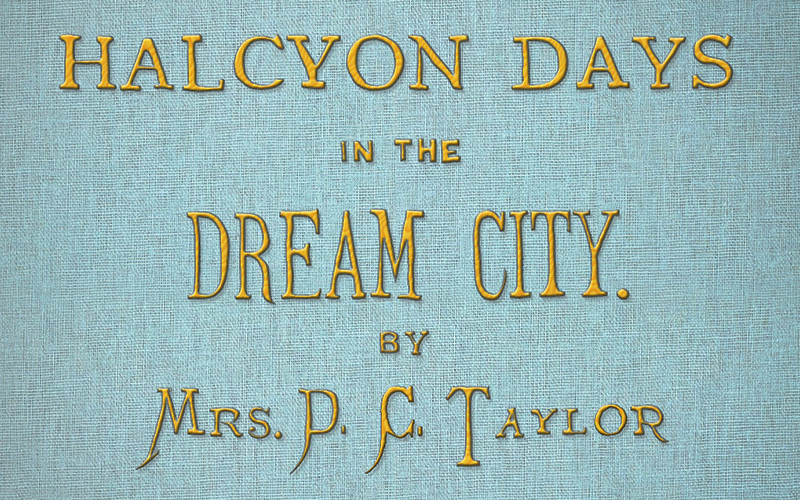Halcyon Days in the Dream City
by Mrs. D. C. Taylor
Continued from Part 15

Let us go through the “Golden Gate,” not the gate of the Holy City, but a gate the architect of which must have been dreaming of wondrous Bible imagery, when he designed it.[1] Arch beyond arch, receding, diminishing as they recede, till the last one is about the dimensions of some grand cathedral door, while the noble proportions of the first, are almost awe inspiring. These are overlaid and thickly incrusted with gold leaf which takes on a faintly greenish tinge, wrought into forms of leaf and flower, vine and spray.
The Transportation Building of the 1893 World’s Columbian Exposition, design by Dankmar Adler and Louis Sullivan. [Image from Graham, Charles S. The World’s Fair in Water Colors. Mast, Crowell & Kirkpatrick, 1893.]
Frieze on the left side of the entrance to the Transportation Building. [Image from Bancroft, Hubert Howe The Book of the Fair. The Bancroft Company, 1893.]
Not far from it the clumsy little vessel in which the early mariners braved the dangers of the deep. We gaze at a lovey electric launch, with lavish ornamentation of paneled, satin polished woods, gay red velvet cushions, and nickel plated finishings, made to glide like a swan upon the surface of the rivers, bearing freight of delicate ladies and dainty gentlemen; while near it stands a long narrow canoe, roughly hewn from a single log, to be propelled by naked savage arms, upon streams that darkly wind through the dense African forest. Broad unwieldy fishing boats, and “slender, arrowy shells;” the man of war with it many devices for shedding man’s blood, and life boats to rescue that same man when the sea is raging, tossing up its white capped billows to engulf him. Yachts like high mettled racing steeds, and here a battered and sea worn craft, that brings to rememberance [sic] the tale of a weak woman’s arm, made strong by a heroic and compassionate woman’s heart. Sacred be thy memory Grace Darling!
The boat used by Grace Darling in 1838 to rescue survivors of the shipwrecked Forfarshire. [Image from Bancroft, Hubert Howe The Book of the Fair. The Bancroft Company, 1893.]
Here is an English tally-ho; gay in scarlet and yellow paint, banded and buckled with russett [sic] leather, balustraded with brass; its roof covered with perilously high seats, where ladies will flutter their ribbons and laces, while the guard blows on his horn, and the roan steeds gallop to the strain. Here are deep hood topped, two-wheeled, Russian droschkys, handsome, heavy, English dog carts, spider-wheeled, American sulkys and trotting wagons, barouches, victorias, surreys, landaus, phaetons, double and single, lining the aisle on either side. Here is a fine open landau, harnessed to it are two prancing dapple-gray horses in trappings of gold tipped patent leather, driven by a white gloved coachman in livery, with two fine kid gloved gentlemen on the back seat, all apparently stricken motionless in mid career, and staring into space with waxen eyeballs.
Vehicles of all types on display. [Image from Bancroft, Hubert Howe The Book of the Fair. The Bancroft Company, 1893.]
Here is a square, blunt ended, Russian sledge, resting so low upon its long runners that it almost touches the ground, overflowing with furs, and calling up visions of iron skies, icy winds, and lonely Russian steppes; and here is a long, velvet lined, American sleigh, with swan shaped prow, calling up visions of winter starlight, and merry lads and lasses gliding over the snow to the music of their own laughter and the “jingle, jingle, jingle of the bells.”
Here is an old worn, torn, leather-covered stage coach, that has made many journeys over the western plains carrying Uncle Sam’s mails, has been in many a battle with the wily savage, and borne the blood stained victors to a place of safety. Here are trucks, farm wagons, bakers carts, delivery wagons, every form of useful vehicle tor the transporting of the world’s merchandise.
Here are rows and rows—a very web and tangle of bicycles, with velvet tires, thread like wheels and glittering plated handles, on which man rushes along, swift and silent as a shadow.
The display of a Chicago bicycle company in the Transportation Building. [Image from Bancroft, Hubert Howe The Book of the Fair. The Bancroft Company, 1893.]
The Empire State Express engine No. 999 on display in the Transportation Building. [Image from Bancroft, Hubert Howe The Book of the Fair. The Bancroft Company, 1893.]
Continued in Part 17
NOTES
[1] One of the architectural wonders of the 1893 World’s Fair was the Golden Door of the Transportation Building, designed by Chicago architect Louis Sullivan.
[2] Shortly after the record-breaking run of the Empire State Express engine No. 999 on May 10, 1893, it travelled to the World’s Fair in Chicago. Retired from service in 1952, the engine returned to the old fairgrounds in 1962 to become part of the collection of the Museum of Science and Industry, where it is on display today.

